THE TRANS-SIBERIAN RAILWAY
By THEODORE WATERS
Frank Leslie's Popular Monthly—March, 1900
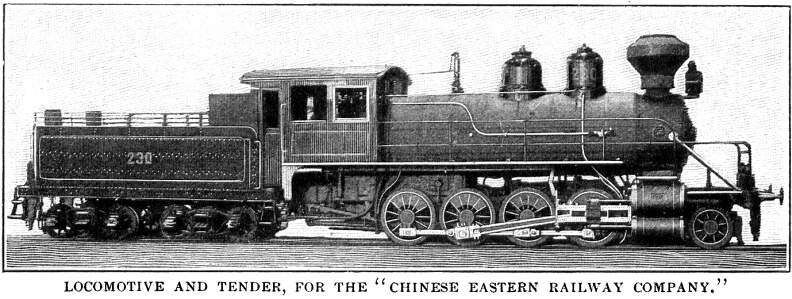
THREE great engineering feats, now in the minds of three leading
nations, promise to alter the commercial and diplomatic conditions
of the world. One is the trans-continental canal route across
Central America. Another is the African Cape-to-Cairo Railway
of Cecil Rhodes. The third is the Trans-Siberian Railway of the
Czar. The first and second of these are hardly beyond the stage
of contemplation. They will be known as Twentieth Century feats.
The last, however, is a Nineteenth Century fact; it is well under
way. European powers are watching its progress attentively, for
it is recognized that, in spite of the Peace Conference suggested
by its projector, it contains all of the essentials for a great
diplomatic coup—a ruse of "the man who walks like a
bear'' to secure ultimately his slice in the partition of the
East. Just now, too, it is of even more interest to the people
of this country than the Isthmian Canal, because, abstractly speaking,
the trans-Siberian Railway is being built in the United States.
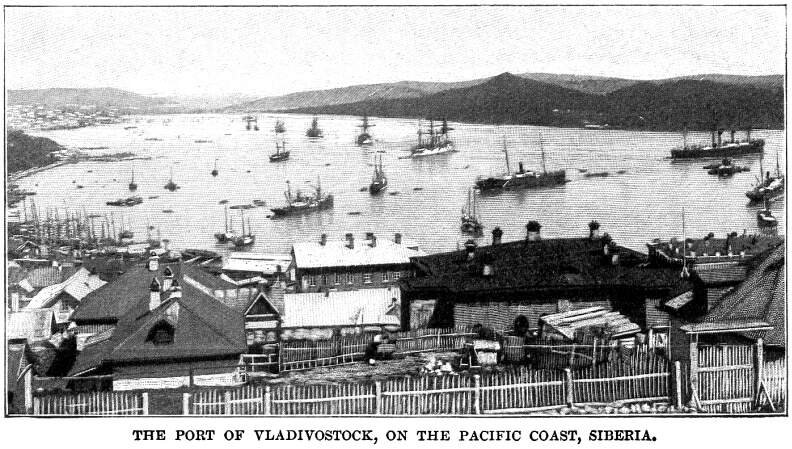
Map
of Asia, showing Trans-Siberian Railway from St. Petersburg to
Vladivostock—400kb
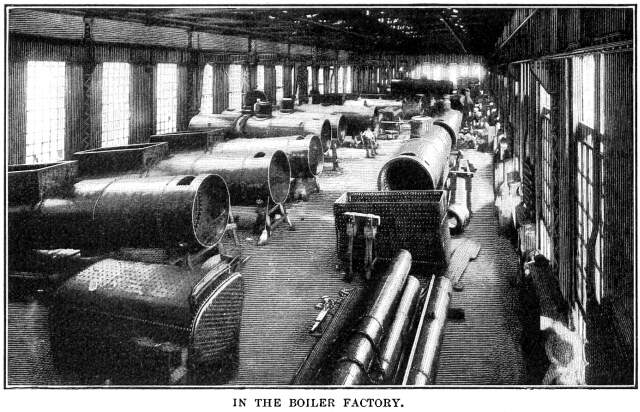 Let the latter proposition be explained
first. The contracts for the equipment of the Siberian road are
being given to American firms. Carnegie and the Maryland Steel
Co. are to supply the rails; Baldwin Locomotive Works are working
night and day on the locomotives; the Pressed Steel Car Co. is
to supply freight-car bodies; Westinghouse and another New York
firm will make the air-brakes and the electrical apparatus; the
bridges are being made at Sparrow Point, Md. Stationary engines
and other features of the machine shop equipment have been made
in Pittsburgh, Cincinnati, Schenectady and other American cities.
Altogether this means the employment of an army of American workmen
and the influx from Europe of many thousands of dollars. Furthermore,
the adoption of these American made goods means that many of the
supplies of the future necessarily will be bought from this country.
In practice it is found much cheaper for a foreign country to
replace a broken driving wheel, for instance, from the original
maker, who keeps it in stock, than it is to make the wheel abroad.
This applies to most of the equipment. So the effect of these
Siberian contracts is highly cumulative. The point is so very
important that it may be interesting to trace out the far-reaching
effects in detail. Let the latter proposition be explained
first. The contracts for the equipment of the Siberian road are
being given to American firms. Carnegie and the Maryland Steel
Co. are to supply the rails; Baldwin Locomotive Works are working
night and day on the locomotives; the Pressed Steel Car Co. is
to supply freight-car bodies; Westinghouse and another New York
firm will make the air-brakes and the electrical apparatus; the
bridges are being made at Sparrow Point, Md. Stationary engines
and other features of the machine shop equipment have been made
in Pittsburgh, Cincinnati, Schenectady and other American cities.
Altogether this means the employment of an army of American workmen
and the influx from Europe of many thousands of dollars. Furthermore,
the adoption of these American made goods means that many of the
supplies of the future necessarily will be bought from this country.
In practice it is found much cheaper for a foreign country to
replace a broken driving wheel, for instance, from the original
maker, who keeps it in stock, than it is to make the wheel abroad.
This applies to most of the equipment. So the effect of these
Siberian contracts is highly cumulative. The point is so very
important that it may be interesting to trace out the far-reaching
effects in detail.
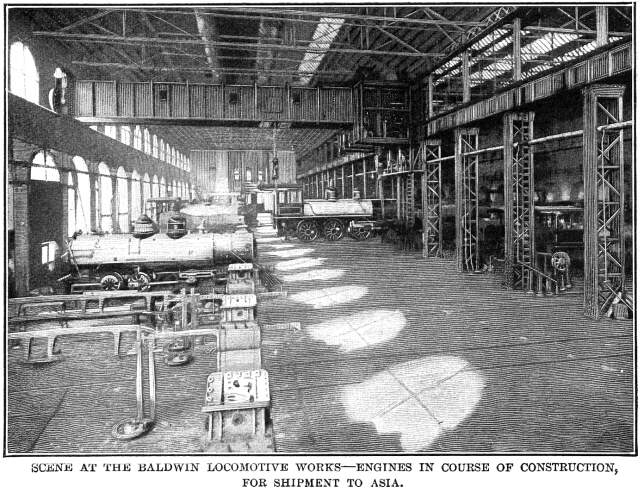 The order for steel rails for which
American rolling mills recently competed was for 180,000 tons.
Since thirty foot rails at eighty pounds to the yard weigh 800
pounds, this order means enough track to equip at least 1,200
miles of road, or approximately the distance between Irkutsk and
the nearest reaches of the River Obi, which for purposes of comparison
are as wide apart as New York and Kansas City. This, be it said
in passing, is but one of the seven working divisions of the new
Siberian road. Most of the iron for this order of rails has not
yet been mined. So that there is prospective work and wages for
the miners who get it out of the ground, for the men who convert
it into steel, for the rollers who make the rails, for the railroads
which handle them, and for the ships which will convey them to
Russia. It will require hundreds of freight cars to draw them
to the coast, and it will need the tonnage capacity of several
steamers the size of the Kaiser Wilhelm der Grosse to take
there to Europe. Yet this large amount of rails will be sufficient
to equip only one-fourth of the line of the Trans-Siberian road
with single track. Three times the above amount will be
needed to equip the entire road in addition to what is ordered
now, not to speak of the sidings necessary for trains to pass
one another. And, if the Russian Government should ever equip
the road with double track, it would mean the duplicating of all
that has just been The order for steel rails for which
American rolling mills recently competed was for 180,000 tons.
Since thirty foot rails at eighty pounds to the yard weigh 800
pounds, this order means enough track to equip at least 1,200
miles of road, or approximately the distance between Irkutsk and
the nearest reaches of the River Obi, which for purposes of comparison
are as wide apart as New York and Kansas City. This, be it said
in passing, is but one of the seven working divisions of the new
Siberian road. Most of the iron for this order of rails has not
yet been mined. So that there is prospective work and wages for
the miners who get it out of the ground, for the men who convert
it into steel, for the rollers who make the rails, for the railroads
which handle them, and for the ships which will convey them to
Russia. It will require hundreds of freight cars to draw them
to the coast, and it will need the tonnage capacity of several
steamers the size of the Kaiser Wilhelm der Grosse to take
there to Europe. Yet this large amount of rails will be sufficient
to equip only one-fourth of the line of the Trans-Siberian road
with single track. Three times the above amount will be
needed to equip the entire road in addition to what is ordered
now, not to speak of the sidings necessary for trains to pass
one another. And, if the Russian Government should ever equip
the road with double track, it would mean the duplicating of all
that has just been
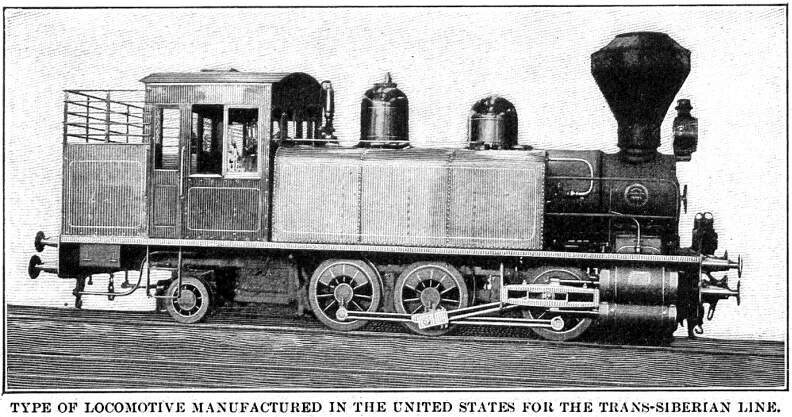
described. In other words, 1,335,000 tons of American steel
would be necessary to supply the Trans-Siberian road with double
track. Finally, when you consider the branch lines which will
tap its 4,741-and-one-third miles of length like the innumerable
branches from the trunk of a great tree and extend away indefinitely
into the wilds of Siberia any distance you please, the mind is
dazed by the infinity of figuring which would be necessary to
arrive even at all approximate estimate. A similar condition presents
itself when the probable cost of such an enterprise is considered;
for even the crude affair now under way is expected to cost the
Russian Government $175,000,000 at the least, and several competent
engineers have declared it their opinion that this estimate is
not large enough by half. Yet, if doled out at first hand without
interest, it is enough to keep 2,500 families in comparative affluence
for fifty years. The possession of just one year's interest on
it at five per cent. would make the man who collected it a millionaire
eight times over.
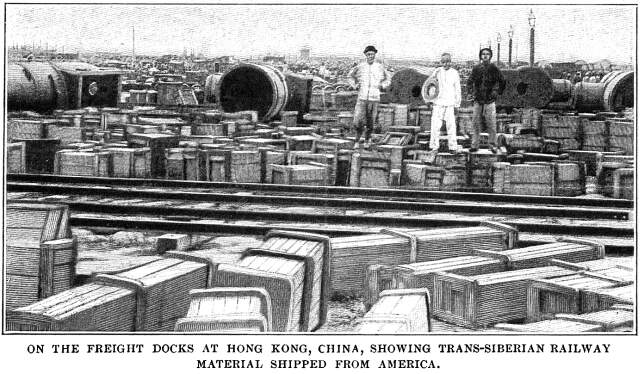 Now, the steel rails are the least
human part of the Trans-Siberian road with which Americans have
to deal. When riding in a railway carriage, one's mind is apt
to stray very seldom to the track, unless it be disagreeably so,
when forced by the jolts and jars. The locomotive, however, is
always of interest and pride to the passengers whom it has pulled.
This feeling will be doubly enhanced for Americans who ride over
the Russian road, because the great locomotives which will draw
the trains were made in Philadelphia. The Baldwin Locomotive Works
have been working night and day, turning out great wood and coal-burning
engines for the Czar. Six thousand seven hundred men are hard
at work on the engines which they construct at the rate of two
a day. Think of it! Two complete locomotives every day in the
year. One would almost think that there would be a glut in the
market. Yet there are factories in Paterson, N. J., Schenectady,
N.Y., Pittsburgh and Scranton, Pa., and in Illinois, with capacities
comparatively as great. It shows the remarkable impetus that has
been given to railroad Now, the steel rails are the least
human part of the Trans-Siberian road with which Americans have
to deal. When riding in a railway carriage, one's mind is apt
to stray very seldom to the track, unless it be disagreeably so,
when forced by the jolts and jars. The locomotive, however, is
always of interest and pride to the passengers whom it has pulled.
This feeling will be doubly enhanced for Americans who ride over
the Russian road, because the great locomotives which will draw
the trains were made in Philadelphia. The Baldwin Locomotive Works
have been working night and day, turning out great wood and coal-burning
engines for the Czar. Six thousand seven hundred men are hard
at work on the engines which they construct at the rate of two
a day. Think of it! Two complete locomotives every day in the
year. One would almost think that there would be a glut in the
market. Yet there are factories in Paterson, N. J., Schenectady,
N.Y., Pittsburgh and Scranton, Pa., and in Illinois, with capacities
comparatively as great. It shows the remarkable impetus that has
been given to railroad 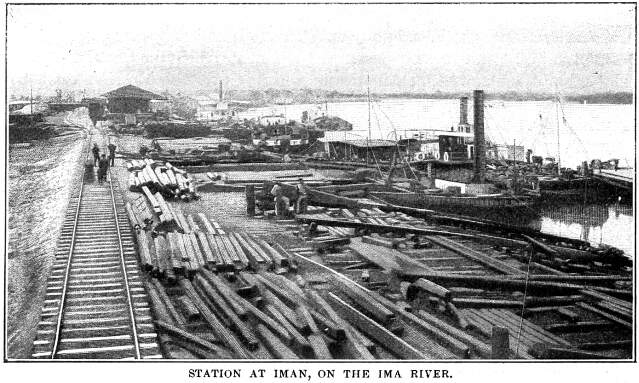 construction—how
the United States in this line is becoming the supply depot of
the world. An instance was recently had of this in Philadelphia,
where the steamship Puritan cleared for Siberia and China
with the largest cargo of railway material that has ever been
taken from any port in the United States. She was bound first
for Vladivostock, and she had on board forty of the locomotives
which had been made at the rate of two a day, tenders for these
locomotives, and eighteen steel bridges for the Chinese Eastern
Railway. These latter she left at New Chwang, China, and the combined
destination is significant from a diplomatic point of view, as
will be seen later in the present article. While the latter is
in course of preparation, another steamship, the Uplands, is
being loaded with a cargo similar to that of the Puritan.
She will go to the same destination. During the latter part of
1898 Philadelphia sent seventy-one locomotives to Siberia, and
an order for seventy-seven is now being executed. In addition
to these it may be said, by the way, that over three hundred other
locomotives were shipped to the Far East last year by American
firms; some for commercial purposes merely, others as part of
the equipment of the Powers, who thus in times of peace are preparing
for the struggle to come. construction—how
the United States in this line is becoming the supply depot of
the world. An instance was recently had of this in Philadelphia,
where the steamship Puritan cleared for Siberia and China
with the largest cargo of railway material that has ever been
taken from any port in the United States. She was bound first
for Vladivostock, and she had on board forty of the locomotives
which had been made at the rate of two a day, tenders for these
locomotives, and eighteen steel bridges for the Chinese Eastern
Railway. These latter she left at New Chwang, China, and the combined
destination is significant from a diplomatic point of view, as
will be seen later in the present article. While the latter is
in course of preparation, another steamship, the Uplands, is
being loaded with a cargo similar to that of the Puritan.
She will go to the same destination. During the latter part of
1898 Philadelphia sent seventy-one locomotives to Siberia, and
an order for seventy-seven is now being executed. In addition
to these it may be said, by the way, that over three hundred other
locomotives were shipped to the Far East last year by American
firms; some for commercial purposes merely, others as part of
the equipment of the Powers, who thus in times of peace are preparing
for the struggle to come.
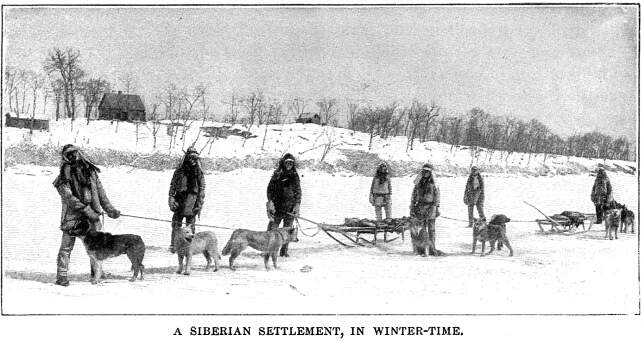 All of the locomotives sent to
Siberia are of the modern type, some of them able to haul 3,200
tons, and all of them fully abreast of the best American engines
of their class. This argues that the road is to be essentially
modern in all of its parts, and not a makeshift from which a growth
is expected to be made. For the standard of a modern railroad
is a matter of dovetailed details. A locomotive weighing, as do
the Siberians, 136,800 pounds, can be operated only on 80-pound
rails laid on a roadbed of corresponding stiffness. The fitness
of things becomes compulsory. Modern cars and rolling stock will
be ordered to accompany the locomotives; none others would fit
the road. All of the locomotives sent to
Siberia are of the modern type, some of them able to haul 3,200
tons, and all of them fully abreast of the best American engines
of their class. This argues that the road is to be essentially
modern in all of its parts, and not a makeshift from which a growth
is expected to be made. For the standard of a modern railroad
is a matter of dovetailed details. A locomotive weighing, as do
the Siberians, 136,800 pounds, can be operated only on 80-pound
rails laid on a roadbed of corresponding stiffness. The fitness
of things becomes compulsory. Modern cars and rolling stock will
be ordered to accompany the locomotives; none others would fit
the road. 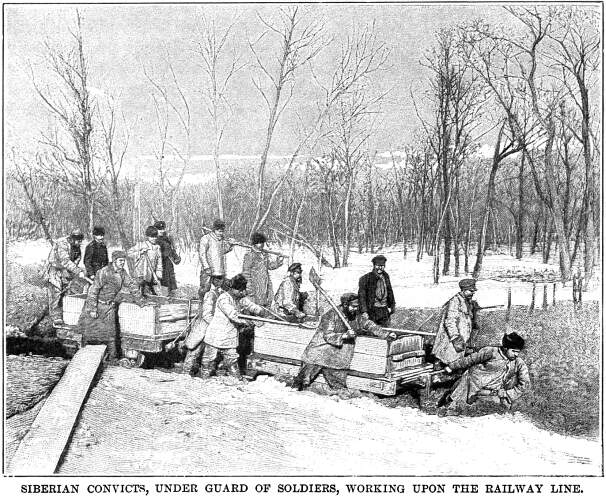 Hence the Russian officials are
compelled to turn to the United States for the rest of the equipment—first,
because of the standard maintained; second, because of the great
speed with which American wares are turned out. The triumph of
the Atbara Bridge on the Nile is proof of this. A Pennsylvania
firm made this bridge just as they might a sky-scraper. They found
the dimensions of the river near Khartum, and then constructed
a complete bridge; all of the parts interchangeable; every rivethole
in its proper place, and every rivet exactly like every other
rivet; every part of the bridge numbered and ready to fit into
its place in the general mosaic. It was, comparatively speaking,
little more than a game at building blocks to set up that bridge—a
matter of weeks, not months or years as it had been before. Finally,
it was a great object lesson to the English engineers, whose eyes
it opened and whose methods it revolutionized. They had been used
to welding the iron forms for foreign bridges and doing the fitting
on the ground. This occupied a long time, for much of the heavy
work was done far from the factory. The American idea causes very
little work to be done on the ground. A complete bridge is made
at home and then exported. The work of fitting is a minor consideration.
This grasp and disposal of the problem in such a masterly manner
has so captivated foreign engineers that an order to send a skyscraper
abroad is logically to be expected in the near future. At any
rate, it could be fulfilled just as was the bridge contract. The
immediate result, however, is the regular exportation of big bridges
and the special exportation of those on the Puritan and
Upland. The company which constructed Hence the Russian officials are
compelled to turn to the United States for the rest of the equipment—first,
because of the standard maintained; second, because of the great
speed with which American wares are turned out. The triumph of
the Atbara Bridge on the Nile is proof of this. A Pennsylvania
firm made this bridge just as they might a sky-scraper. They found
the dimensions of the river near Khartum, and then constructed
a complete bridge; all of the parts interchangeable; every rivethole
in its proper place, and every rivet exactly like every other
rivet; every part of the bridge numbered and ready to fit into
its place in the general mosaic. It was, comparatively speaking,
little more than a game at building blocks to set up that bridge—a
matter of weeks, not months or years as it had been before. Finally,
it was a great object lesson to the English engineers, whose eyes
it opened and whose methods it revolutionized. They had been used
to welding the iron forms for foreign bridges and doing the fitting
on the ground. This occupied a long time, for much of the heavy
work was done far from the factory. The American idea causes very
little work to be done on the ground. A complete bridge is made
at home and then exported. The work of fitting is a minor consideration.
This grasp and disposal of the problem in such a masterly manner
has so captivated foreign engineers that an order to send a skyscraper
abroad is logically to be expected in the near future. At any
rate, it could be fulfilled just as was the bridge contract. The
immediate result, however, is the regular exportation of big bridges
and the special exportation of those on the Puritan and
Upland. The company which constructed 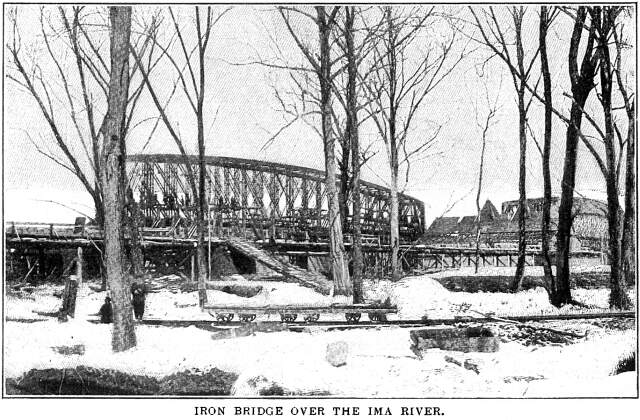 the
Atbara bridge has just closed a contract to supply 7,000 tons
of bridge work for the government railways of Japan. This, in
detail, embraces 45 double-track 100-foot spans and 11 single-track
200-foot spans. Other firms are competing for contracts in bridges
for the Chinese railways, and exportations of the same kind are
expected to be made in token of the contemplated African railways.
This, while perhaps a trifle foreign to the subject in hand, is
yet essential in view of the interlacing aspirations of the Powers
in the East. The Russian bridges were many of there made by a
Maryland firm, and they are of the kind that are first built and
then erected. the
Atbara bridge has just closed a contract to supply 7,000 tons
of bridge work for the government railways of Japan. This, in
detail, embraces 45 double-track 100-foot spans and 11 single-track
200-foot spans. Other firms are competing for contracts in bridges
for the Chinese railways, and exportations of the same kind are
expected to be made in token of the contemplated African railways.
This, while perhaps a trifle foreign to the subject in hand, is
yet essential in view of the interlacing aspirations of the Powers
in the East. The Russian bridges were many of there made by a
Maryland firm, and they are of the kind that are first built and
then erected.
There has been for some time in America a scarcity of steel,
which may bear heavily on the contract for freight cars exported
to Siberia. It is not that there is any lack of raw material,
judging the supply by previous production; but the inflated exportation
of steel goods and the consequent activity of otherwise idle factories
have thinned out the flow in the regular channels. Some of the
big manufacturers, used to absorbing all the necessary ore in
sight, have been compelled to make common issue and cause with
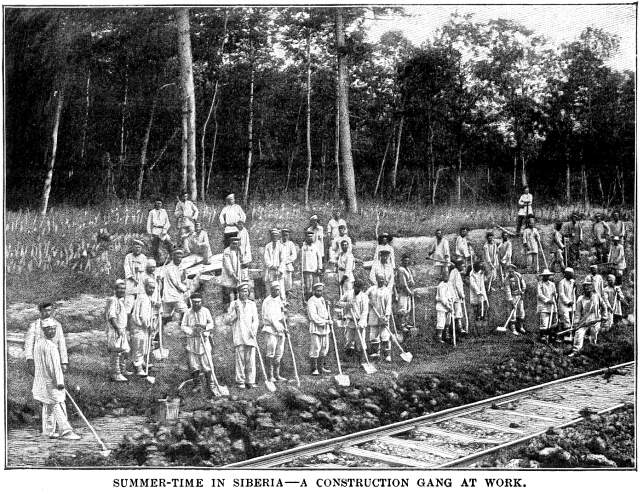 the smaller men. To complicate
the situation, there has been also a "famine" of freight
cars, due, as with steel, less to the scarcity (judged by former
standards) than to the immense and immediate acceleration in the
movement of freight. This, also, in spite of the fact that the
wheel loads of freight cars have quadrupled in a few years. Now,
the modern freight car is not the wooden affair to which we have
been used. It is made of steel, stamped out, and the various parts
pressed into shape so that it may be exported conveniently. This
feature of the car has led to orders from foreign countries, the
most important being the Russian contract. In view of this find
the extra demand at home, a car manufacturing company asked Carnegie
to supply them one thousand tons of steel a clay for ten years.
Steel, at the average market rate, is worth $20 a ton, so that,
with an average of 300 working days in the year, the order will
in the end be worth $6,000,000, facts of time and money of great
encouragement to the wage-workers who turn out this vast amount
of metal. Here again the advantage of the skyscraper idea in American
steel-making becomes apparent. How much easier and economical
to export the forms of knocked-down steel cars to be set up in
Siberia than to send space-consuming wooden cars which would have
to be made and braced before shipment, even if the Russians thought
well of ordering the latter style at all! the smaller men. To complicate
the situation, there has been also a "famine" of freight
cars, due, as with steel, less to the scarcity (judged by former
standards) than to the immense and immediate acceleration in the
movement of freight. This, also, in spite of the fact that the
wheel loads of freight cars have quadrupled in a few years. Now,
the modern freight car is not the wooden affair to which we have
been used. It is made of steel, stamped out, and the various parts
pressed into shape so that it may be exported conveniently. This
feature of the car has led to orders from foreign countries, the
most important being the Russian contract. In view of this find
the extra demand at home, a car manufacturing company asked Carnegie
to supply them one thousand tons of steel a clay for ten years.
Steel, at the average market rate, is worth $20 a ton, so that,
with an average of 300 working days in the year, the order will
in the end be worth $6,000,000, facts of time and money of great
encouragement to the wage-workers who turn out this vast amount
of metal. Here again the advantage of the skyscraper idea in American
steel-making becomes apparent. How much easier and economical
to export the forms of knocked-down steel cars to be set up in
Siberia than to send space-consuming wooden cars which would have
to be made and braced before shipment, even if the Russians thought
well of ordering the latter style at all!
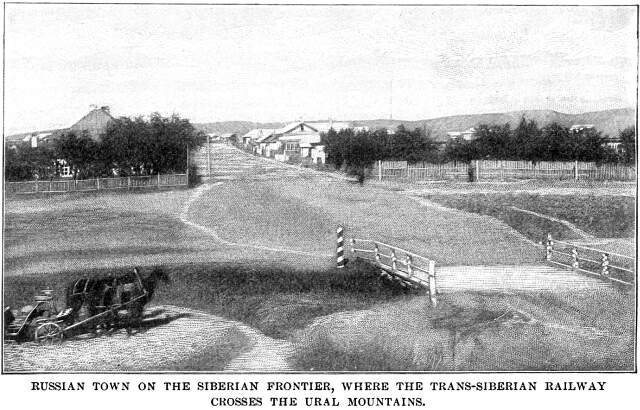 Following out this eternal dove-tailing
of the standards, each one of these locomotives, these freight
cars, etc., must be equipped with an air-brake, an American product
which so far has not been equalled in efficiency by any other
device made for the same purpose. Furthermore, the universality
of the patents is so complete that the Russians are compelled
to come to the United States for the right to provide this means
of stopping their trains. In the matter of shop equipment for
the minor repairs which inevitably will be necessary, the machinery
is all being made in and exported from the United States. Much
of the machinery used in constructing the road has come from the
same source. Following out this eternal dove-tailing
of the standards, each one of these locomotives, these freight
cars, etc., must be equipped with an air-brake, an American product
which so far has not been equalled in efficiency by any other
device made for the same purpose. Furthermore, the universality
of the patents is so complete that the Russians are compelled
to come to the United States for the right to provide this means
of stopping their trains. In the matter of shop equipment for
the minor repairs which inevitably will be necessary, the machinery
is all being made in and exported from the United States. Much
of the machinery used in constructing the road has come from the
same source.
Let us now seize the economic moral of the situation from another
standpoint. In the rolling mills where the rails for the Trans-Siberian
Railway are being made, ten thousand men are employed. Six thousand
seven hundred men are at work on locomotives for the road. The
bridge-making companies employ 5,000 men. The freight car companies,
six thousand. The Westinghouse and the New York Air Brake companies
keep five thousand men at work. So that on these items alone there
are over 32,000 Americans at work for the Czar of Russia. The
families of these men, roughly estimating them at three persons
besides the men themselves, although we believe this too small,
bring the number of Americans, men, women and children, depending
for sustenance on the Trans-Siberian Railway to 128,000. This
is a direct result of the triumph of our methods over those of
our foreign competitors. The indirect result, such as the number
of Americans employed in the handling of the supplies on the way
to the coast; the prosperity resulting from the commercial contact
of those employed with their neighbors; the employment of the
neighbors on work which otherwise would have been performed by
those now engaged in the Siberian work; the prestige which the
United States as an industrial factor must achieve among nations;
the impetus which the work must give to iron construction in the
United States, so that she may feel herself competent to step
in and demand her share of the immense railroad development impending
in Asia, Africa, South America and Australia—the indirect
result is indeed too great to be calculated. In its way the construction
of the Trans-Siberian Railroad is an epoch-opening event in the
history of American industry.
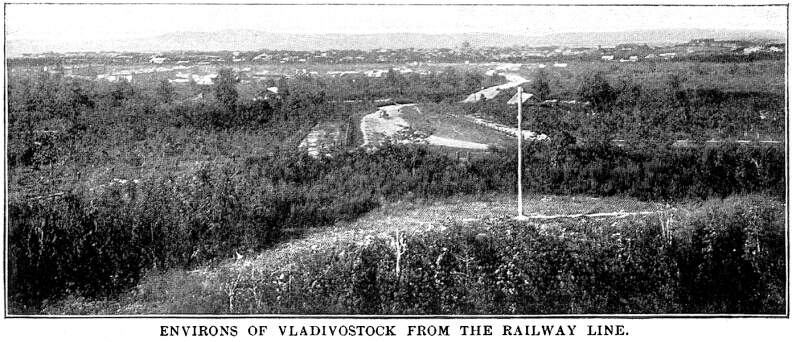
Now, having witnessed the immediate and indicated the ultimate
effect of the Trans-Siberian Railroad on the prosperity of the
United States, let us leave our army of American workmen to turn
out the equipment, and look to the road itself and its probable
effect on social and commercial Russia in particular and on Europe
and Asia in general. This great railway has been in the eye of
Russian diplomacy ever since the war of the Crimea. Possibly it
was a project before that, but that struggle showed the need of
a broader development than Russia had indulged in theretofore.
The great modern trend toward centralization was recognized as
an increasing force by the advisers of the Czars quite as readily
as by the ministers of other countries. Europe, which had entered
the Nineteenth Century as a composite of many principalities,
had merged into a comparative few great "powers"; commerce,
which had meant formerly the traffic of town with town, now meant
gigantic interchange between hemisphere and hemisphere; language,
which had been divided and subdivided into a babel of tongues
over limited areas, until people on two sides of a mountain employed
different and unrecognizable idioms, was rapidly simplifying into
the collective speech of a few great nations; dress, which had
been an emotional masquerade all over the world, had been universally
simplified, until, for the male at least, one's nationality was
not to be recognized by one's raiment; travel, which had meant
months of journeying from State to State, now meant short weeks
of globetrotting—and so on through all the departments of
life. This great centralizing process, this intercommunication
of human actions, ideas and habits, might go on, theoretically,
until the whole world was a unit—one great country, one commercial
system, one language, one mode of dress, etc., etc.; but in the
ultimate result the influence, the impress, the force, of one
great nation was bound to predominate. It might be England, it
might be Germany, it might be France; but yet again it might be
Russia. At any rate, her rulers began to adjust her destinies
apparently to this end. Geographically she covered one-seventh
of the land area of the globe, which merely numerical designation
is qualified by the valuable location she held on the map of Europe
and Asia. Her commerce so far lay in the products of the soil,
but the nucleus was as great as the matured development of some
other countries. Her language was spoken by over 119 million persons,
and she sought earnestly to maintain this showing by severely
discouraging the growing use of the French language in polite
circles. In dress, which is unimportant, she followed the line
of least resistance and adopted the fashion of the world. But
in other things she was far less tractable. She had ways and customs
of her own, modeled on the governmental and religious traditions
of the empire, and she did not mean to give them up. However,
her disposition being more Asiatic than European, she set about
adapting the condition of affairs to suit her needs in a manner
diplomatic, inconspicuous, but nevertheless forceful. It was a
great movement, and a slow one; but, like all great movements,
its momentum became irresistible and promised to be world-disturbing.
Where England or Germany might have coerced, Russia persuaded,
and then menaced the result of her persuasion with silent alternatives.
She insidiously allowed her Jewish population to discern and to
develop her outlying commercial advantages, and then quietly annexed
the resultant development for the benefit of her Greek Church
adherents. She made a hidden virtue of her penal system and scattered
the best blood of the Empire over the cold-bitten wastes of Siberia,
in the end to develop it and fit it for its place in the ultimate
prosaic. While other countries noisily forced their way into the
commercial recesses of China, she hung along the northern border
of the Yellow Kingdom, studying the customs of the Mongol, foreseeing
his needs and, in the Asiatic manner, worming her way to his heart.
She sought to do for him inversely what the Chinese Wall once
had done for his forefather. He had closed communication with
the outside world with a great northern girdle of stone; Russia
hoped to open it for him with a girdle of steel—the Siberian
Railroad.
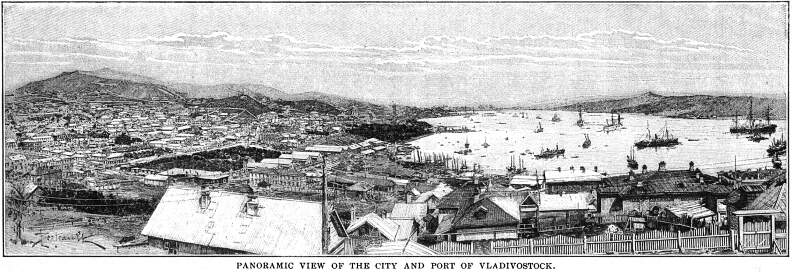
It was undoubtedly a significant event that the United States
should have beaten England in the competition for the Russian
contracts. One can find in it material for farther illustration
of the secret methods of the Czars. For the Siberian road certainly
constitutes the greatest menace a to the trade supremacy in China
of other countries than Russia. Let us see how this may come to
be. The Trans-Siberian road as originally projected was to be
one of three routes leaving Russia at the convenient terminal
point of some existing railway, and extending eastward somewhere
above the northern boundary of Mongolia and Manchuria, and dipping
southward after crossing the Amur River to Vladivostock, on the
Bay of Peter the Great, which latter is an inlet of the Japan
sea. These three routes, which may be likened to our Northern,
Central and Southern Pacific Railroads, were discussed more in
the light of diplomatic and commercial expedients than in vices
of the engineering difficulties likely to be encountered. One
of these routes was to be a continuation of the already existing
Ural Mines Railway, extending eastward through the barren northlands.
The Southern route was to be a prolongation of the old Orenburg
Railway, across the unpeopled steppes and through the Barnaul
mining district. The Central route which was chosen eventually
will extend through a fertile, well peopled country between the
objectionable rivers and marshes on the north and
the barren steppes on the south—a course which will permit
of its, so to speak, living on the country as it advances. But
mark the set purpose kept always in view. These routes all converged
and met at Nijni Udinsk, less than half of the way across Siberia,
so that the plan of hemming in the complete northern boundary
of the Chinese Empire was never for one moment abandoned. It is,
indeed, the intention of the Russia Government to occupy all three
routes in the indefinite future.
If you will examine the prospectus issued by the Russian Department
of Grade and Manufacture, you will find a carefully prepared statement
of the ostensible purpose of the Trans-Siberian Railway. Here,
for instance, is the proposed route: Starting at Tcheliabinsk
and extending to the River Obi, thence to Irkutsk, to Misovskaya,
to Srjetensk, to Khaborovka, to Grafskaya, to Vladivostock. In
May, 1891, the Czarovitch, now Emperor Nicholas II., broke ground
for the road by digging the first sod at Vladivostock. It is also
a fact, that part of the road has been built north from this point
around the northeastern border of Manchuria. Yet it is thought
that this part of the road may be subsidiary—a mere branch
of the main intention. Let us see why! If you will take the map
of China and look for its railroads, you will find probably two
or three spasmodic sections of coal roads which have survived
the prejudice of ancestor worshipers and which lean toward the
coast as though afraid of extending too far into the unprotected
interior. The longest of these roads extends from Peking to Tien-tsin,
and thence northeasterly, nearly three hundred miles, to Ning-yuan.
Its general trend is from the capital of China toward Vladivostock.
But this comparatively short length of line will soon be only
part of a great system of Chinese railroads. It will be remembered
by the reader that the Imperial Government granted a concession
last year to a Chinese-American syndicate, headed by the late
Senator Brice, for the purpose of constructing a railway from
Hong Kong on the China Sea, via Canton, to Han-Kau. Han-Kau is
in the center of one of the most fertile and populous districts
in the empire. Another concession was made to a Belgian syndicate
for a line extending north from Han-Kau to Peking. So, with the
line already in existence and the proposed lines named in the
concessions, there shortly will be in China a continuous railway
route starting at Hong-Kong and extending through the middle of
the country past twenty cities, running through the fertile valleys
of the Yang-tse-Kiang and the Hoang Ho, where the value of the
soil products is very great, passing over mountain ranges where
the value of the mineral deposits is greater, touching half a
dozen ports on the Gulf of Pechili from which communication with
the sea is convenient, and finally, having accomplished all this,
making a dead-set in the direction of the Tram-Siberian terminus—Vladivostock.
It is not too much for say that the Russians have anticipated
this, and that the trend of their road will be altered en route
to take advantage of the Chinese development. Critics of the Eastern
situation have openly asserted their belief in the Russian intention
to make Port Arthur a terminus of the road. One eminent writer
declares that part of the present route of the Siberian road will
for a time be abandoned and a sharp turn be made at Streusk on
the Shilka River, so that the main line can pass directly through
Manchuria, and joining a branch line from VIadivostock at Kirin
or Kalyuen, pass down to the Chinese terminus at Ning-yuen. Then,
indeed, will the Czar control the main artery of land communication
in the East. The line which will probably follow the route of
the Grand Canal; the Central Chinese line, described above; the
line which probably will stretch away from Hail-Kau through the
valley of the Yang-tse to India and Thibet—these will all
be feeders for the great project which the Czar inaugurated in
May, 1891. He will be able to move and to control the movement
of crops and merchandise between the Atlantic and the Pacific,
and he will be able at a critical moment to hurry great legions
of his conscripted soldiers from one side of the globe to the
other in a manner which no other country will be able to anticipate.
Having already appealed to the Chinese mind through the oneness
of double dealing which characterizes the two nations, he will
be able to cement the feeling into a positive and declared alliance
which will enable these two nations absolutely to control the
politics of Asia to the enforced exclusion of European powers—China
to avoid the personal disadvantages of partition, Russia to enjoy
the political and commercial advantages of exclusive intercourse.
This is the end striven for. If it comes to pass, Russia will
dominate the greater part of the world.
Meantime let us see how the work of preparation is being carried
out. The Trans-Siberian Railway at the time of the present writing
is approaching Lake Baikel, and hence may be said to be half finished.
It has accomplished the point where the three routes converged
and has already started to skirt the northern edge of Mongolia.
The work is being pushed forward rapidly, but not so rapidly as
it might be were the engineering methods employed a little more
modern than they are. There is an underlying taint of corruption
in the work, as may be seen from soiree recent reports concerning
the treatment of the laborers. The laborers are unskilled or skilled,
according as they are native or foreign to the soil. Many have
been imported, but the majority are drawn from the masses of Siberian
convicts and exiles. The convicts are forced to work on the road;
the exiles are "induced" to do so. For the former, eight
months of labor counts as one year of penal servitude; for the
latter, one year of work on the road counts as two of exile. But
there is much free labor. A recent report giving an approximate
estimate of the force employed, is as follows: 37,000 laborers;
14,000 carters; 6,000 surfacemen; 5,000 carpenters; 4,000 stonemasons;
2,000 riveters; or roughly, a total—counting the directors
and sub-directors in charge—of 70, 000, men.
The Government is offering great inducements to the peasants
of Russia to settle in Siberia, and as a result emigration has
been filling up the fertile plains of the Obi and the Irtish and
the land beyond. Forty-three acres of land are given to each peasant
settling in the provinces of Tobolsk and Tomsk, and every family
is entitled to a reduction in railway fare, which makes the cost
of traveling a mere trifle—one shilling per one hundred miles.
Of course, once at his destination, the settler must stay, the
return journey being possible only at a rate far beyond his means.
The scheme amounts therefore to permanent colonization. One hundred
thousand emigrants left the crowded Russian communes for Siberia
in 1892; 100,000 went in 1893; 180,000 in 1894. The number has
been increasing since. One hundred thousand passed over the border
during the single month of May, 1896. During 1898 the great mob
of home-seekers numbered 400,000, all rushing madly into the land
which but a few years ago was synonym for terror and desolation.
Spectators have said that the movement resembles a panic, and
that worse still, the authorities, unprepared for the gigantic
influx, have been unable to provide for it, and that many of the
emigrants are herded like cattle en route, around stations,
in cars, in wayside inns, etc., where the necessaries of life
even are not enjoyed in any great abundance. Many of these emigrants
have stopped to labor on the railroad and so become part of the
engineering system, which is better off in the way of supplies,
since it is entitled to live on the country it penetrates. Doubtless
many of these men will remain railway servants all of their lives,
for even when the road is completed there will be needed an army
of laborers for its maintenance, those required merely to clear
away snowdrifts during several months in the year forming no inconsiderable
number.
So the work is being pushed forward with engineering difficulties
that seem wellnigh insurmountable; through long valleys where
summer is a question of a month or two and the frosts never leave
the ground; over great rivers like the Tobol, the Ishim, the Irtisch
and the Yenisei, which have to be bridged while the floods carry
down long barriers of ice; over high mountains, like those of
the Yablonovai range, where a summit level of 3,685 feet is reached,
where the subsoil is continually frozen and the cuts are filled
with snowdrifts; over trackless wastes where the compass and the
sun are the only guides; over inclosed seas like Lake Baikel,
across which the Trans-Siberian trains will be transported bodily
on 4,000 ton steamers, which will have to force their way through
the ice. Later on, this boat-crossing may be done away with, but
if so it will be at a cost of fifty-four miles of tunneling and
cutting through granite, gneiss and sandstone. These are the difficulties
of this great engineering work. Probably no other railway in the
world will have been constructed at such an expense of energy,
money and human suffering. Will the end justify the means? In
the opinion of the Czar, to whom these things are but necessary
pedestal blocks to his throne—Yes! Already the results begin
to manifest themselves. A recent dispatch from St. Petersburg
states as follows: "The increase of the traffic on the eastern
and still more on the western section of the Siberian Railway
has surpassed all expectation. The last year's traffic returns
of the western Siberian section show 300,000 passengers, nearly
490,000 tons of goods, and 400,000 peasant emigrants. Last winter,
although 600 new trucks were added and 1,600 old ones borrowed,
there was an accumulation of 1,000 truck loads of goods for which
no means of transport could be found. Of the 490,000 tons carried
over the railway in 1898, more than 320,000 tons consisted of
cereals. With the opening of the through traffic to the Pacific,
the extension of the road as a carrying agent, must be enormous.
It is calculated that five years hence, the Trans-Siberian Railway
will have a goods traffic of 1,700,000 tons per annum.
 "It is proposed to spend over
$40,000,000 in developing traffic during the next few years. Heavier
rails and side tracks are to be laid, and 1,429 bridges reconstructed.
The average speed of trains is now 20 versts (13.26 miles) an
hour for passenger, and 12 versts ( 7.956 miles) an hour for goods
traffic. When the reorganization is complete, it will be possible
to run trains at 50 versts (33.15 miles) an hour, which would
enable them to travel from Moscow to Vladivostock in ten days.
The distance separating the Atlantic from the Pacific could then
be traveled in considerably less than a fortnight." "It is proposed to spend over
$40,000,000 in developing traffic during the next few years. Heavier
rails and side tracks are to be laid, and 1,429 bridges reconstructed.
The average speed of trains is now 20 versts (13.26 miles) an
hour for passenger, and 12 versts ( 7.956 miles) an hour for goods
traffic. When the reorganization is complete, it will be possible
to run trains at 50 versts (33.15 miles) an hour, which would
enable them to travel from Moscow to Vladivostock in ten days.
The distance separating the Atlantic from the Pacific could then
be traveled in considerably less than a fortnight."
The Russians are prone to revere an auspicious date. In May,
1705, Peter the Great founded his capital, St. Petersburg, "thereby
breaking through the Neva a window into Europe." In May,
1905, the present Nicholas II hopes to be able to travel on his
railway continuously from the " Window of Europe" to
Vladivostock, the "Golden Gate of the East." It will
be an epoch-marking anniversary, for it will probably produce
as lasting an effect on the Asian world as did the act of the
elder Czar on the European.
Stories Page | Contents Page
|







